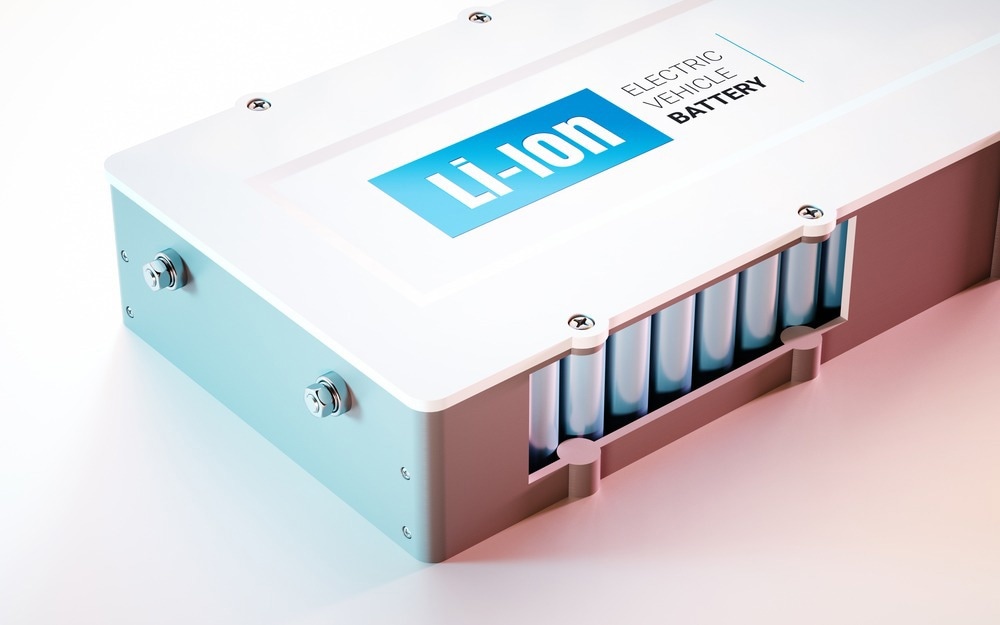A recent study published in The Journal of Physical Chemistry C integrates in-situ and ex-situ scanning electron microscopy (SEM), and energy-dispersive X-ray spectroscopy (EDX) methods to provide detailed insight into the degradation processes of silicon nanoparticles-based electrodes in lithium-ion battery cells during the charging/discharging cycles.

Study: Visualization of Degradation Mechanisms of Negative Electrodes Based on Silicon Nanoparticles in Lithium-Ion Batteries via Quasi In Situ Scanning Electron Microscopy and Energy-Dispersive X-ray Spectroscopy. Image Credit: petrmalinak/Shutterstock.com
Identifying the degradation processes of silicon nanoparticle-based negative electrodes is critical for solutions against active materials fracture, pulverization, or substantial development of the solid electrolyte interphase (SEI).
Ex-situ technologies for the post-mortem study of lithium-ion battery materials include scanning electron microscopy (SEM) and energy-dispersive X-ray spectroscopy (EDX). Although in-situ technologies give more precise results, they need specially built batteries and electrolytes with increased evaporation temperatures, limiting their practical applications.
Silicon Nanoparticles: The Future of Lithium-ion Batteries (LIBs)
Silicon (Si)-based materials are regarded as the most viable substances for developing novel negative electrodes because of their high-power density and energy storage capability. The growth of silicon-based electrodes is fueled by their high theoretical specific capacitance, ease of availability, and cheap cost of silicon.
However, silicon-based electrodes suffer from rapid capacity withering and short cycle life because of the significant volumetric expansion/contraction and substantial development of the solid electrolyte interphase (SEI).
Several approaches can be employed to mitigate these degrading effects, such as electrolyte reagents, binders, preventive surface coverings, and nanostructured conductive polymers. However, using commercially accessible silicon nanoparticles (SiNPs) is regarded as the most effective strategy for reducing volumetric changes and electrode pulverization of LIB cells.
Post Mortem Analyses for Investigating Degradation Mechanisms of SiNPs
Post mortem investigations, like scanning electron microscopy (SEM) and energy-dispersive X-ray spectroscopy (EDX), are popular and efficient approaches for investigating the deterioration processes of silicon nanoparticle-based electrodes.
Ex-situ analysis means that the charging/ discharging cycle is stopped at the appropriate battery capacity and health, the cell is disassembled, and the dry electrode is analyzed using SEM and EDX. After the investigation, the electrode is normally discarded. In opposition to ex-situ SEM, in-situ/operando studies are performed without the cell being disassembled.
Although ex-situ SEM and EDX can give useful information, the pictures of various electrodes are not as accurate as same-spot measurements obtained using the in-situ/operando approach. Therefore, the development of in-situ/operando methods is necessary to get a thorough knowledge of the degrading processes of silicon nanoparticles-based electrodes in lithium-ion batteries
Highlights of the Current Study
In this study, the degradation processes of pure silicon nanoparticles-based composite electrodes, including pulverization, irreversible volumetric change, and surface degradation products, were investigated using quasi-in-situ (QUIS) SEM and EDX during the charging/discharging cycles.
The advantages of in-situ and ex-situ investigations are combined in QUIS-SEM and EDX analysis. A recurrent ex-situ same-spot assessment is done in a protected atmosphere, resulting in SEM pictures that give precise insights into aging processes as if taken in-situ.
LIB cells with a conventional organic carbonate-based electrolyte were operated under typical working conditions throughout the experiment. During charge/discharge cycling, the cells were opened on many occasions at the same battery capacity. To guarantee a protected quasi-in-situ atmosphere, the electrodes based on silicon nanoparticles were taken from the cell non-destructively and maintained in an inert environment.
Research Findings and Future Perspective
The findings demonstrated that the QUIS-SEM/EDX approach allows for multiple cycles of imaging of the silicon nanoparticles-based electrode surface at the same area with minimum beam degradation and good spatial precision.
When various discharge rates were compared after ten cycles using the QUIS technique, the permanent volumetric expansion was found to be dominant at lower discharge rates, but the fragmented structure was shown to be dominant at higher discharge rates.
Furthermore, the analysis of the constant growth of degradation products on the surface revealed that fluorine-based degradation products form on the conducting additive rather than the silicon nanoparticles, implying that the conducting additive is an essential factor in creating a homogeneous SEI and the degradation of LIB cells.
Altogether, QUIS-SEM/EDX can solve potential imaging/analysis technological shortcomings in understanding the degrading impacts of silicon nanoparticles and silicon nanoparticle-based composite electrodes for lithium-ion batteries.
Reference
Dienwiebel, I. et al. (2022). Visualization of Degradation Mechanisms of Negative Electrodes Based on Silicon Nanoparticles in Lithium-Ion Batteries via Quasi In Situ Scanning Electron Microscopy and Energy-Dispersive X-ray Spectroscopy. The Journal of Physical Chemistry C. Available at: https://pubs.acs.org/doi/10.1021/acs.jpcc.2c03294
Disclaimer: The views expressed here are those of the author expressed in their private capacity and do not necessarily represent the views of AZoM.com Limited T/A AZoNetwork the owner and operator of this website. This disclaimer forms part of the Terms and conditions of use of this website.